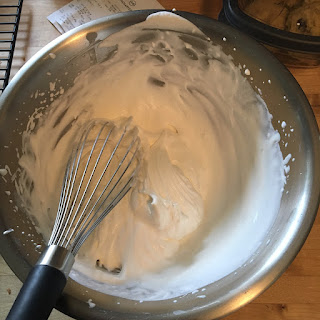I've learned (as you probably already know if you've been following me for a while) that I really need to read all the way through recipes and not just launch into them. And this was no exception. If you take a quick glance at the second column of the Boston Cream Pie ingredients, you'll see that "1 recipe chilled pastry cream" is required. (That sound you're hearing in the background is me flipping pages upon reading that, trying to figure out what I needed to do - and how long it might take.)
 |
| The recipe is from The King Arthur Flour Baker's Companion, as is the recipe for the pastry cream, which follows. |
I was heartened by the fact that the description says that this is a "custard" filling and correct for what I was making. (Though... really... would a cookbook say that it wasn't the right thing? Consider that as we move forward.)
Basically, the recipe (at least for the first half of it) is the tale of two sets of ingredients, which you kind of have to go back and forth between.
I started with separating my eggs.
 |
| Note to self: Don't forget the four egg whites on the bottom shelf of the fridge. |
Cold side, part two (part one was the egg separating): mix together the rest of the milk, the flour, corn starch, and eggs. This, at least, gives us kind of texturally interesting photos.
 | |
| As a side note: is there any kitchen ingredient that has a more pleasant texture than corn starch? I got some on my fingers, and it's just so silky. |
Then I whisked together the stuff in the bowl. (Not terribly exciting, but at least it looked different when I was done.)
Finally, we're getting close to a boil.
Eventually...
Unfortunately, one of the more interesting steps takes place as you temper the eggs by pouring just a little of the boiling milk/sugar into the eggs and whisking it together. I did this in three portions, 1/4 cup at a time, and whisked like crazy to avoid making milky scrambled eggs.
Why is this so unfortunate? Because I couldn't take photos while simultaneously pouring and whisking.
When I was done, though, the tempered egg mixture went into the pan with the rest - and magic started to happen.
First, the milk changed color (because, you know, egg yolks).
 |
| My thumb looks HUGE! |
Within about 30 seconds, it was the consistency of warm pudding. Unfortunately - at least for me - it simply smelled like scalded milk and scrambled egg. Not exactly what you hope for when you see something like this.
The next step (pushing it all through a sieve) is an interesting one. I think it might be more important if you are using a full vanilla bean, instead of vanilla extract, but it did remove a few little corn starch/flour lumps (which you can see in the second photo, below).
Happily, the eggy scent changed pretty quickly when I added the vanilla and butter (which, honestly, I didn't think would melt down - but it did).
 |
| Is it just me, or does this look like cheese curds gone awry? |
I was, quite suddenly, in possession of a warm, thick, vanilla custard. I could have eaten it with a spoon and been quite happy. But the recipe had more steps, so I decided to be good and keep going.
There are those times when working with new recipes that you think "Are you sure?" as you read through the steps. This was one of those points. I had the incredible thick custard in my bowl, and was reading that I needed to whip up some cream to finish it. I was beginning to wonder if the cookbook writers had missed a notation of "If this is for Boston Cream Pie, you're done, here. If not, keep going." - or maybe they had meant something entirely different. But...
As I've done for most recipes I've tested, I went ahead and followed the directions. Which, again, gave us a few kind of boring photos. Take, for instance "cream in bowl":
And also "whipped cream in a bowl":
So... I was standing in the kitchen with glorious, smooth custard in one bowl and cream whipped to soft peaks in the other. And I was still wondering if I really wanted to mix the two.
I figured, though, that the recipe knew what it was talking about, so I started folding them together, which was looking a little rough at first.
 |
| I really kind of expected that the custard would "flatten" the cream and keep everything a bit more dense. It did a little. But not much. |
It tasted good, but the flavor was no longer as strong as it had been in the custard, alone.
I looked at it and wondered how it would hold up to being the filling between the layers of my Boston Cream Pie. But that would have to wait until I got the rest of the ingredients put together. (Also known as next week's blog post...)
-----
Want me to try out a recipe of yours that sounded good but turned out "meh"? Or some recipe you've always thought about trying but didn't want to make without more information? Let me know and I'll see what I can do!


























